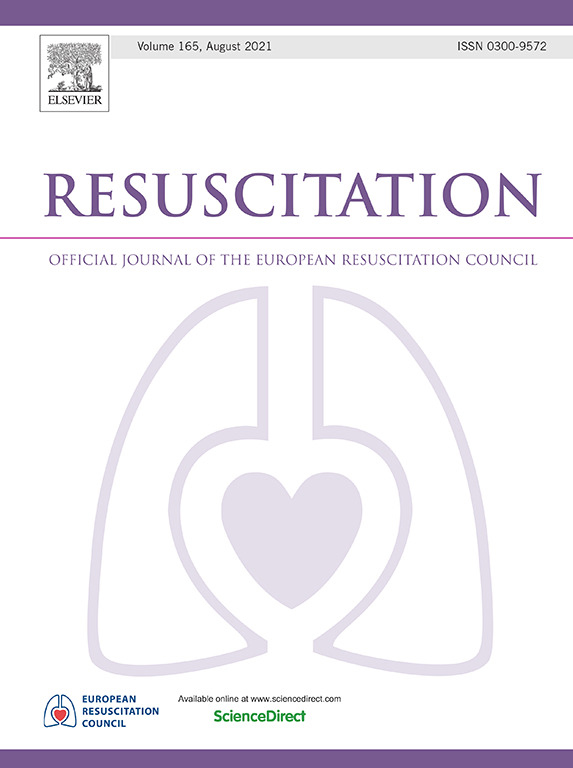在疑似阿片类药物相关的院外心脏骤停中旁观者干预的障碍:911呼叫的多方法研究
IF 4.6
1区 医学
Q1 CRITICAL CARE MEDICINE
引用次数: 0
摘要
导言:阿片类药物相关院外心脏骤停(OA-OHCA)是美国的一个重要问题。非专业干预,包括旁观者CPR和纳洛酮可以提高生存率,但与其他OHCA相比,障碍可能有所不同。本研究旨在描述9-1-1呼叫者和疑似oa - ohca患者的特征,并确定B-CPR和纳洛酮给药的障碍。方法:对北卡罗来纳州两个县(2022年5月至2023年12月)疑似OHCA的9-1-1电话进行回顾性多方法研究。包括成人非创伤性ohca。数据分析采用描述性统计和Student’st检验/Chi2。我们使用了主题分析和演绎与归纳相结合的方法。结果:疑似OA-OHCA患者比非疑似OA-OHCA患者年轻(39岁vs 58岁)[结论]:我们发现疑似OA-OHCA与非疑似OA-OHCA在人口统计学上存在显著差异。我们还在这一人群中发现了独特的障碍,以及先前描述的障碍,这些障碍可能在疑似吸毒的情况下被放大。可能需要一种不同的心脏复苏方法来最大化治疗和生存。本文章由计算机程序翻译,如有差异,请以英文原文为准。
Barriers to bystander interventions in suspected opioid-associated out-of-hospital cardiac arrests: A multiple methods study of 9-1-1 calls
Introduction
Opioid-associated out-of-hospital cardiac arrests (OA-OHCA) is a significant problem in the United States. Layperson interventions, including bystander CPR and naloxone may improve survival, but barriers may differ compared to other OHCA. This study aims to describe characteristics of 9-1-1 callers and patients in suspected OA-OHCAs and identify barriers to B-CPR and naloxone administration.
Methods
This was a retrospective multiple methods study of transcribed 9-1-1 calls for suspected OHCA from two counties in North Carolina (5/2022–12/2023). Adult, non-traumatic OHCAs were included. Data were analyzed using descriptive statistics and Student’s t-test/Chi2. We used thematic analysis and a combined deductive and inductive approach.
Results
Patients with suspected OA-OHCA were younger than non-suspected OA-OHCA patients (39 vs 58 years [p < 0.01]). Most patients were in a residence, however, this percentage was smaller in suspected OA-OHCA compared with non-suspected OA-OHCA (68 % vs 88 % [p < 0.01]). Most callers in the suspected OA-OHCA group were a friend of the patient (35 %), whereas most callers in the non-suspected OA-OHCA population were a family member (34 %) [p < 0.01]. Qualitative barriers unique to suspected OA-OHCA included: conflicting responsibilities, fear of drugs, and fear of the patient. Naloxone-specific barriers included lack of availability and lack of knowledge of use.
Conclusion
We found significant differences in demographics between suspected OA-OHCA compared with non-suspected OA-OHCA. We also identified unique barriers in this population as well as previously described barriers which may be amplified in the setting of suspected drug use. A different approach towards cardiac resuscitation may be needed to maximize treatment and survival.
求助全文
通过发布文献求助,成功后即可免费获取论文全文。
去求助
来源期刊

Resuscitation
医学-急救医学
CiteScore
12.00
自引率
18.50%
发文量
556
审稿时长
21 days
期刊介绍:
Resuscitation is a monthly international and interdisciplinary medical journal. The papers published deal with the aetiology, pathophysiology and prevention of cardiac arrest, resuscitation training, clinical resuscitation, and experimental resuscitation research, although papers relating to animal studies will be published only if they are of exceptional interest and related directly to clinical cardiopulmonary resuscitation. Papers relating to trauma are published occasionally but the majority of these concern traumatic cardiac arrest.
 求助内容:
求助内容: 应助结果提醒方式:
应助结果提醒方式:


